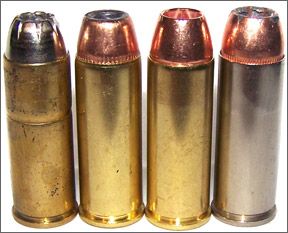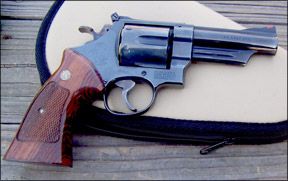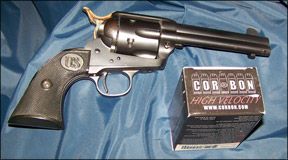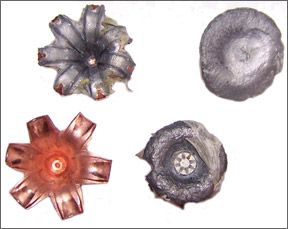When we speak of big-bore handguns and the calibers that begin with a 4, the 45 Colt cartridge is among the most respected. (Sometimes the 45 Colt is called the 45 Long Colt, we wont rehash that one here.) The 45 Colt in its original loading was introduced in 1873. This hoary old cartridge is the oldest centerfire handgun cartridge still in common use. The 45 Colt was designed as a martial cartridge. While we usually view handguns as short-range personal defense tools, the 45 Colt cartridge was often used at longer range in fighting aboriginal opponents. The cartridge was reputed to be capable of taking down an Indian war pony at 100 yards. The 45 Colt cartridge earned its reputation as a defense cartridge the hard way-not through opinion, but through front-line use. Aside from the Army and Marine Corps, the Texas Rangers, the Royal Canadian Mounted Police and the New York State Patrol were just a few users of the 45 Colt cartridge.

It is interesting that there are currently three and perhaps four power levels loaded in the 45 Colt. Two we are not concerned with. First, there are ultra-hot loads designed for hunting revolvers. The Ruger Blackhawk and the Freedom Arms 454 Casull will handle such loads. Your Uberti would probably be turned into a hand grenade. The second class of loading we are not concerned with are Cowboy loads. These usually use a 250- or 255-grain bullet running at 800 fps or less. We have clocked these loads as slow as 650 fps. While in the .455 Webley class, these are not loads we deem suitable for personal defense.
For much of its service life in the West, the 45 Colt was castrated by expedient. To make the same load usable in both the short cylinder “backup issue” Smith & Wesson 45 Schofield and the 45 Colt, the Schofield, a shorter, less powerful cartridge, was the general issue cartridge for both revolvers. One of our raters remarked that this is most interesting because today the 45 Colt standard loads and the 45 Colt +P defense loads offer much the same relationship. When we are testing 45 Colt +P loads, we are testing loads suitable for use in the Taurus Judge, Smith & Wesson double-action revolvers, and the strong US Fire Arms (USFA) single-action revolvers and the Ruger Vaquero. These are not Ruger Blackhawk-only loadings, but neither are they pipsqueaks.
The original 45 Colt full-power load pushed a 255-grain conical bullet to more than 900 fps. Today, outdoorsmen use a standard handload of a 250-grain semi-wadcutter at about 1000 fps. While this is a powerful load, a personal-defense load should use an expanding bullet for greater wound potential and also to limit penetration in the interest of public safety. It is interesting to note that although there are revolvers in this caliber available in the double-action format from Ruger, Smith & Wesson, and Taurus, there are few defensive loads available. We were able to test four loads from three different makers.

The loads tested are generally available, although truth be told you may have to settle for your second choice in these days of ammunition shortages and ammunition hoarding. We did not differentiate in the tests between standard pressure and +P loads, we let the performance of each round stand on its own merits. Frankly, we feel that the +P loads tested are standard power compared to the original 45 Colt load, while the modern standard loads are downloaded in deference to older guns and the many brass-frame and cut-rate single-action revolvers. The SAAMI may not agree with our opinion.
We tested two standard-pressure loads, which were the Winchester 225-grain Silvertip X45CSHP2, $19.62/20, along with Speers 250-grain Gold Dot 23984 at $29.86/20. In the +P format, we fired the Cor-Bon SD45C200, a 200-grain JHP that costs $33.02/20, and the all-copper 225-grain Cor-Bon DPX DPX45C225, pricey at $51.39/20.
We used two proven revolvers. As a test of double-action defensive revolvers, we used a Smith & Wesson Model 25-5 with a 4-inch barrel. Four inches is optimum for a defensive big-bore revolver. The handgun is quick from leather, but offers excellent accuracy potential to 50 yards. We also tested the loads in a USFA Rodeo single-action revolver with 4.75-inch barrel. Quite a few Cowboy Action shooters keep a similar revolver around for home defense. This is the personal handgun of one of our raters, who served as a peace officer for more than 20 years. He often carries this revolver while boondocking. If the handgun is only a projectile launcher, these two are as good as any. Point by point, heres how the selections did:

Reliability:It isnt true that reliability is a non-issue with revolvers. Bullets may jump the crimp in revolvers under recoil, and the cartridge must exhibit a good crimp and also good casemouth seal and primer seal. All of the loads tested showed good cartridge integrity. None moved in recoil, all fired with every blow of the hammer, and for the most part exhibited a full powder burn with little muzzle flash.

Sight Regulation: The Smith & Wesson features adjustable sights and may be zeroed to the point of aim with any reasonable load. However, the fixed-sight Rodeos shots struck several inches high at 25 yards with 250-grain loads. Sight regulation with the Rodeo was nearly ideal with the 200-grain Cor-Bon load, and the Silvertip load went just a fraction of an inch low at 25 yards. The DPX fired high, and so did the Federal 250-grain load. If you use a fixed-sight revolver, this is a consideration. The 250-grain loads will strike about the same point as Cowboy loads using the same weight bullet; the lighter bullets will strike lower. Within the narrow band of velocity exhibited, Cowboy loads are close enough in impact to perform well as practice loads for defensive revolvers.
Accuracy and Control. All loads were more than accurate enough for personal defense. However, the DPX showed truly excellent accuracy, as the accompanying table details. The USFA Rodeo showed lower SDs, and good accuracy with the more experienced shooters firing the accuracy tests. This revolver has a rather tight barrel-to-cylinder gap and has always demonstrated excellent accuracy. Yet, it is free of the common complaint of single-action revolvers building up powder residue and beginning to bind. Naturally, the Smith & Wesson double-action revolver is the better choice for defense work.
Gun Tests Grade: A
Cor-Bon 45 Colt 225-Grain DPX45C225 +P, $51.39/20. The Cor-Bon DPX is head and shoulders above the rest, with more than 17 inches of penetration and the all-copper bullet expanding to 0.85 inch, almost twice its unfired size. There was no loss of bullet weight after expansion and penetration. This load is not only suitable for defense against humans, it would be useful against the big cats, feral dogs, and the smaller bears. The DPX is also very accurate. The only drawback in performance is recoil. Our resident single-action fan reports that the load kicks less than his benchmark 250-grain/1000-fps load, but neither is something you wish to fire in large quantifies at a setting. In range tests with the double-action revolver, we were able to achieve good results and reasonably rapid double-action pairs. This load is worth mastering, even though it costs nearly twice what some of the others cost. You have to ask if that one shot you may have to make during a critical incident is worth the expense.
Gun Tests Grade: B+
Cor-Bon 45 Colt SD45C200 200-Grain JHP +P, $33.02/20. This open-mouthed 200-grain hollowpoint penetrated 14 inches, with average expansion of 0.75 inch. The recovered bullet weighed 183 grains. The Cor-Bon 200-grain load also fired to point of aim in the Rodeo. The lighter Cor-Bon load suffers in comparison to the DPX, but no other 45 Colt loading we tested. In fact, some may prefer the lower penetration for urban use compared to the DPX loading. The 200-grain Cor-Bon is also easier to use, with less recoil. The raters were split about which load they would use, but those who contemplate outdoor adventures favor the DPX.
Gun Tests Grade: B
Speer 45 Colt 23984 250-Grain Gold Dot, $29.86/20. The Speer 250-grain Gold Dot bullet has the weight of the original 45 Colt load, and it proved accurate. However, it is quite slow, even for this cartridge, at 775 fps. Gelatin tests, however, were impressive. We realize that there is more to the equation than wound value, but this is the value that is demonstrable. Energy transfer is not. As an example, a faster bullet striking bone will often create bone fragments as secondary missiles. The Gold Dot bullet traveled 14 inches in gelatin before coming to rest at an expanded 0.75 inch.
Gun Tests Grade: C
Winchester 45 Colt X45CSHP2 225-Grain Silvertip, $19.62/20. The Winchester Silvertip, to the best of our knowledge, was the original 45 Colt hollowpoint. (Federal once offered a lead semi-wadcutter hollowpoint as competition to it.) Expansion was at the bottom of the scale and accuracy, not a long suit of the 45 Colt as a rule, but especially poor compared to the other loads. In favor of the Silvertip, felt recoil was the lightest of any tested. Powder burn was clean. Expansion was consistent across the board. This load is simply outclassed by the others. To the best of our knowledge, this load is 20 years older than the Gold Dot, as an example. GT






























They are all going to hurt!
How can I find out more about it?